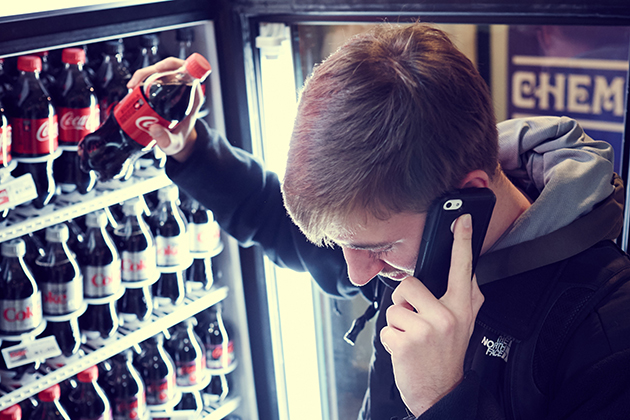
Online word-of-mouth has assumed a prominent role in consumers’ purchasing decisions, according to a UConn research team that studied the social media accounts of carbonated soft drink producers.
According to Yizao Liu, assistant professor, and Rigoberto Lopez, professor of agricultural and resource economics in the College of Agriculture, Health, and Natural Resources, what really matters is the volume of the social media word-of-mouth rather than the sentiment expressed in a tweet or Facebook comment.
Using Nielsen Co. data sets to measure the sales volume of soda producers, the researchers found a connection between online conversations and demand. Information was collected on 18 carbonated soft drinks brands sold in 12 designated market areas from April 2011 through October 2012. Data included dollar sales, volume sales, and prices for both diet and regular carbonated soft drinks for supermarkets with more than $2 million annual sales. Social media data from Facebook, YouTube, and Twitter were also collected during the same time frame.
As an example of how a successful social media campaign can increase product exposure, Liu and Lopez cited the Coca-Cola Co.’s “Share A Coke” social media campaign conducted on Facebook in 2011. During that campaign, in which consumers could order personalized Coke bottles through a Facebook app, traffic on the Coke Facebook site increased by 870 percent. The campaign earned a total of more than 18 million media impressions and led to a 7 per cent increase in total sales.
Findings from this research were presented in a paper titled “The impact of social media conversations on consumer brand choices” at a joint symposium of the Agriculture & Applied Economics Association, the European Association of Agricultural Economists, and the Canadian Agricultural Economics Society held in Montreal earlier this year. Funding for the research was provided by the Zwick Center for Food and Resource Policy at UConn, through a USDA-National Institute of Food and Agriculture grant.
Public health implications
The data about consumer preference are especially relevant in an era when, according to the U.S. Centers of Disease Control and Prevention, more than one-third of adults in this country are obese. In addition, obesity has more than doubled in children and quadrupled in adolescents in the past 30 years, leading to major health-related concerns as these young people mature into adulthood.
Since the consumption of sugar-laden products, including soda, is an important component of this surge in obesity rates, knowing what motivates a consumer to choose one brand over another can be invaluable to researchers. Not only does this influence how products are marketed, says Liu, it also has implications from a national health policy perspective.
“Results of these studies suggest that social media can also play an important role in raising consumer awareness about the dangers of consuming high calorie, sugary drinks,” she says. “This gives us a whole new platform for reaching people in a way that is both non-threatening and effective.”
For example, by monitoring various social media sites, Liu and Lopez established that, on average, consumers respond favorably to higher amounts of caffeine in carbonated soft drinks, but dislike high sodium content and, as might be expected, higher prices. However, while consumer response to sugar content is negative, it is not statistically significant, they found.
Terms of engagement
Liu and fellow researcher Huaxia Rui, a professor in the Simon Business School at the University of Rochester, are also studying both “direct engagement” – social media messages sent by consumers directly to companies producing particular brands – and “indirect engagement,” or messages containing brand-related hashtags.
According to Liu, research shows that indirect engagement on Twitter (using a hashtag combined with a brand name) has the largest impact on influencing choice, followed by direct engagement on Twitter (using @ followed by the brand name). These are followed by messages from consumers who “like” and follow a brand on Facebook, and then by the number of Google searches looking for a particular brand of carbonated soft drink.
Overall, she says, Coca-Cola has been “liked” nearly 90 million times on Facebook. Dr Pepper has more than 300,000 Twitter followers; and the other leading brand, Pepsi, has 24 million Facebook friends and 3 million followers on Twitter.
“The industry that makes Coke, Pepsi, Sprite, and other carbonated soft drinks provides an ideal laboratory,” says Liu, “because it has embraced various forms of social media as a way of reaching consumers, and we can capture most of the data we need, almost in real time, right from our computer screens.”


